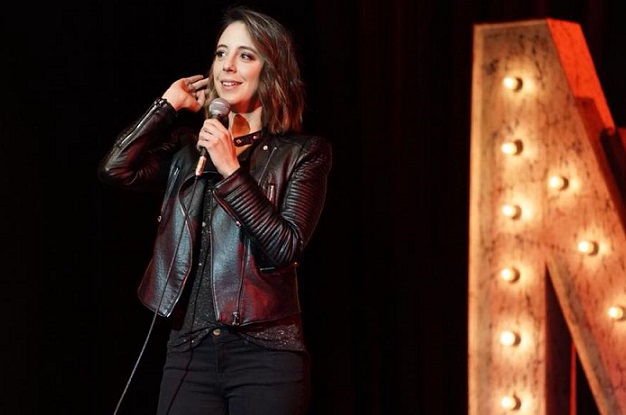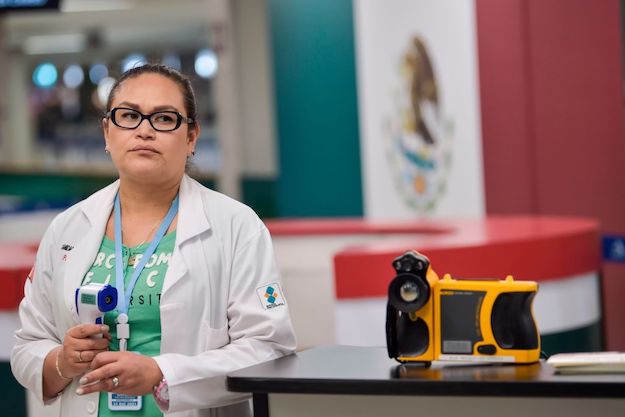Stand-up comedian Sofía Niño de Rivera approached the microphone in front of a Ciudad Juárez auditorium wobbling on six-inch heels – and entirely wrapped in layers of gray packing foam and black duct tape.
She was bullet-proof.
“Everyone was asking me when I was coming to Juárez, and if I was scared,” she told the audience that packed the Benito Juarez Auditorium in November. “I said ‘no way.’”
Niño de Rivera’s dark, unapologetic humor has won her both fans and critics. In September, death threats forced her to cancel a show in Chihuahua, the capital city of the historically violent border state of the same name.
The reason? She poked fun at life in the provincial state in the 2016 Netflix special that launched her career, “Sofía Niño de Rivera: Exposed.”
Siempre va a ganar la comedia. Gracias Juárez por el Sold Out y por saber reír de todo. Fueron un público increíble. #sobrevivichihuahua pic.twitter.com/EgVuS6yjBT
— Sofia Niño de Rivera (@sofffiaaa) November 11, 2017
Niño de Rivera, 36, is the first female comedian with an original Spanish-language stand-up special on Netflix and the second overall, behind fellow Mexican comedian Ricardo O’Farrill.
Stand-up comedy in Spanish might be a new genre, but it is growing fast. In 2016, Netflix released four stand-up specials, all by Mexican comedians: two by O’Farrill, one by Niño de Rivera and one by Carlos Ballarta. In 2017, it released eight more – two by Chilean comedians, and another six by Mexicans – and in 2018, it expects to put out at least another 15 specials, according to a news release.
While English-language stand-up comedy has a longer track record and more artists – Netflix released 26 specials in 2016 and 45 in 2017 – it is clear Netflix is serious about its investment in Spanish-language content.
In part, this is due to demand from a booming international audience. While Netflix does not release viewership data, its 2017 third quarter earnings report shows it gained 4.45 million international members, totaling just over 56 million subscriptions abroad. Within the U.S., it gained 850,000 members that quarter, totaling nearly 53 million subscriptions and more than 100 million worldwide.
“It is the continued adoption of Internet entertainment that is driving our growth,” Netflix’s Chief Financial Officer David Wells said in the third quarter earnings call in October. “Notably, our global originals are helping drive that.”
Stand-up comedy is also a natural fit for Netflix. When asked about the sudden investment in the genre during the first quarter earnings call, Chief Content Officer Ted Sarandos said that the format works well with Netflix because it’s uncensored and commercial-free, allowing comedians to retain their creative freedom.
“There’s always been an interest in stand-up comedy,” Sarandos said in April 2017. “You could [draw] serious level and movie level viewing on some of these stand-up comedy specials if you pick them right and invest in them properly. So these were big-ticket investments, but they’re also performing like big-ticket content, so we’re thrilled with this so far.”
Jump-starting her career was hard for Niño de Rivera. She had grown up watching American stand-up comedians like Jerry Seinfeld, Bill Cosby and Ricky Gervais. But when she quit her job in advertising to become a full-time comedian eight years ago, she had few women – and no Latin Americans – to draw from. She attended clown classes in Mexico to learn physical comedy, but later had to go to New York for comedy workshops.
“I had never seen stand-up in Mexico,” she said. “So I didn’t think it existed, or at least in the way that I wanted to do it. When I started I was the only one.”
The Mexican actor Héctor Suárez Gomís, whose show she considers more of a monologue than stand-up, let her open his shows a few times. This gave her a chance to develop her material. While she was able to earn enough to make rent, she sold her car and curtailed her spending for the first five years.
“It was really hard, as it is for any stand-up comedian,” Niño de Rivera recalled. “It’s a lot of gigs in places where there little to no people, or in bars, in homes, anywhere they would give you a microphone, basically.”
Niño de Rivera credits many factors for the initial interest in Spanish-language comedy. But now that comedians like herself have a platform, and viewers got a taste of something new, the tendency is for the genre to continue growing.
“Mexican comedy had not evolved in a long time,” she said. “It was good to have another choice. Netflix saw an opportunity because people were watching it.”
—
Tameez is a multimedia journalist in New York.








